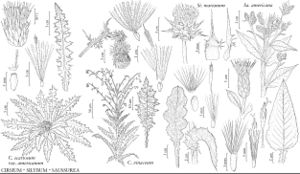Difference between revisions of "Silybum marianum"
Fruct. Sem. Pl. 2: 378. 1791.
FNA>Volume Importer |
FNA>Volume Importer |
||
| Line 8: | Line 8: | ||
}} | }} | ||
|common_names=Blessed milkthistle;chardon Marie | |common_names=Blessed milkthistle;chardon Marie | ||
| − | |basionyms={{Treatment/ID/ | + | |basionyms={{Treatment/ID/Basionym |
|name=Carduus marianus | |name=Carduus marianus | ||
|authority=Linnaeus | |authority=Linnaeus | ||
| + | |publication_title=Sp. Pl. | ||
| + | |publication_place=2: 823. 1753 | ||
}} | }} | ||
|synonyms= | |synonyms= | ||
| Line 52: | Line 54: | ||
|publication year=1791 | |publication year=1791 | ||
|special status= | |special status= | ||
| − | |source xml=https://jpend@bitbucket.org/aafc-mbb/fna-data-curation.git/src/ | + | |source xml=https://jpend@bitbucket.org/aafc-mbb/fna-data-curation.git/src/f6b125a955440c0872999024f038d74684f65921/coarse_grained_fna_xml/V19-20-21/V19_171.xml |
|tribe=Asteraceae tribe Cardueae | |tribe=Asteraceae tribe Cardueae | ||
|genus=Silybum | |genus=Silybum | ||
Revision as of 18:35, 24 September 2019
Stems glabrous or slightly tomentose. Leaves: basal wing-petioled, blades 15–60+ cm, margins coarsely lobed; cauline leaves clasping, progressively smaller and less divided, bases spiny, coiled, auriculate. Phyllary appendages spreading, ovate, 1–4 cm including long-tapered spine tips. Corollas 26–35 mm; tubes 13–25 mm, throats campanulate, 2–3 mm, lobes 5–9 mm. Cypselae brown and black spotted, 6–8 mm; pappus scales 15–20 mm. 2n = 34.
Phenology: Flowering Feb–Jun (west), Jul–Sep (north).
Habitat: Roadsides, pastures, waste areas, sometimes cultivated
Elevation: 0–800 m
Distribution

Alta., B.C., N.B., N.S., Ont., Que., Sask., Ala., Ariz., Ark., Calif., Conn., Ind., La., Mich., Miss., Nev., N.H., N.J., N.Mex., N.Y., N.C., Ohio, Oreg., Pa., Tenn., Tex., Vt., Va., Wash., W.Va., s Europe (Mediterranean region).
Discussion
Silybum marianum is sometimes cultivated as an ornamental, a minor vegetable, or as a medicinal herb. Young shoots can be boiled and eaten like cabbage and young leaves can be added to salads. The seeds can be used as a coffee substitute. Extracts of S. marianum are used as an herbal treatment for liver ailments.
Selected References
None.
